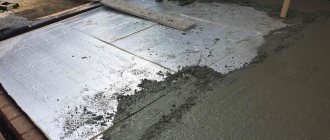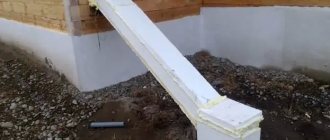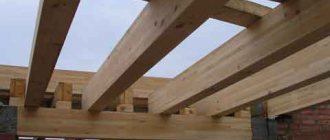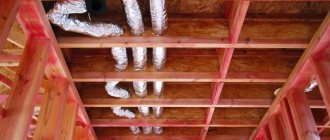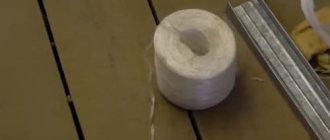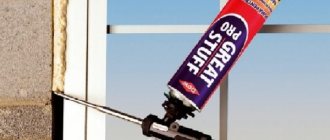In winter, at least 25% of the heat is lost through the roof of an uninsulated building; the losses are compensated by increased heating. Of course, the load falls on the heating system and entails increased energy consumption. A budget-friendly way to solve the problem is to insulate the ceiling in a private house; the attic remains cold. The overlap is smaller than the roof slopes in area, hence the savings. Our task is to tell you how to properly insulate a ceiling by first selecting the appropriate materials.
How to choose the right insulation thickness
Since the thickness of mineral wool affects the thermal characteristics of the thermal insulation system, it should be selected taking into account the climatic conditions of the region of residence, air humidity, and technical characteristics of the insulated surface. The averages are approximately as follows:
- For an external wall, where it is necessary to achieve the standard indicator of the material’s resistance to heat transfer, the recommended thickness of mineral wool should be from 8 to 10 cm.
- For basements (walls, ceilings), surfaces in contact with the ground - the layer of insulating material should be from 6 to 15 cm.
- The thickness of mineral wool for the floor in a heated room is at least 6 centimeters, with a maximum thickness of 15 cm.
- The thickness of mineral wool for the ceiling of a house in contact with an unheated attic should range from 10 to 16 cm.
- Pitched roofs should be insulated with thermal insulation material with a thickness of 15 to 30 cm.
Average data may vary depending on the climate in the region of residence.
Internal insulation
The need for internal ceiling insulation is most typical for houses with several floors or with an attic, as well as for city apartments. The entire scope of work consists of the following stages:
- Ceiling lathing - can be made of boards with a section of 30-40 x 100-200 mm (the width of the board directly depends on the thickness of the insulation layer) or a metal profile. The lathing is attached to the ceiling using nails or self-tapping screws, and the distance between adjacent parts should be about 50-60 cm, depending on the width of the mineral wool used.
Ceiling lathing
A layer of waterproofing is attached to the finished sheathing - strips 50-60 cm wide are cut out plus a tolerance of 5 cm on each side, i.e. the final width will be 60-70 cm. These strips are attached with counterbattens to the wooden sheathing or with self-tapping screws to the profile.
Next, mineral wool is laid and fixed with glue or a construction stapler to the ceiling, or, if the layer is thick, to the sheathing.
Fastening mineral wool to the ceiling
The next layer is a vapor barrier using glassine. It is mounted on mineral wool using a stapler. The finished structure is secured by transverse fixation of counter rails or profiles.
We attach mineral wool to the ceiling
The internal insulation procedure is completed, the next step is installation of plasterboard, panels or stretch ceilings on the sheathing.
Option No. 1 – foam insulation
The work of laying this heat insulator is not difficult:
- Concrete slabs generally have a flat surface, so surface leveling problems rarely occur. All you have to do is putty the joints between the plates, or better yet fill the cracks with polyurethane foam.
- The next step is to apply a deep penetration primer to the ceiling twice. Since smooth concrete has low adhesion, without this treatment the required effect will not be achieved.
- Next, they take pre-prepared sheets of insulation, spread them with adhesive and apply them to the ceiling surface. Many craftsmen place them without gaps, as densely as possible. But there will still be gaps between the sheets, so they are initially glued with a gap of 5 - 7 millimeters. Then the gaps are filled with foam, the coating is continuous.
- But polystyrene foam should not be left in this state, since it is a flammable material and the ceiling looks ugly. Its surface needs to be plastered. To do this, apply a layer of Ceresit CT83 3–4 millimeters thick with a spatula and immediately embed a reinforcing fiberglass mesh in it.
- Next, to be on the safe side, the foam plastic is additionally secured with umbrella dowels, which requires a hammer drill. A hole is drilled in the concrete through the thickness of the ceiling insulation, a plastic dowel is placed in it and the central rod is driven in. For one square meter of such fasteners you will need 5 pieces.
When everything is dry, begin applying the decorative finish. If you don’t want to use Ceresit CT8, you can use any starting plaster, but before doing this, the foam should be primed.
If the ceiling is to be insulated with this material in a wooden building, then the insulation is laid between the load-bearing beams to their entire depth and the gaps are foamed. The ceiling is hemmed from below, and it is better to fill the subfloor on top, since you will have to move around the attic. In this case, installation of a vapor barrier is not required, since moisture is not dangerous to the foam.
Despite the fact that there is a large selection of adhesive compositions on the construction market, experts most often use the following three options:
- "Liquid Nails"
. High-quality glue, but the process of applying it is not easy and therefore when using it you need to follow the instructions. - Polyurethane foam
. A pattern of it is applied to a sheet of foam plastic. Then they apply insulation to the ceiling. Next, the sheet is pressed against the surface several times over the course of an hour, since the foam expands and until this process is completed, the material will move away a little. - Dry mix Ceresit CT83
. It is simply diluted according to the instructions, applied to the sheet using a notched spatula and glued. If such a tool is not at hand, it is necessary to lay “buns” at several points and attach the insulation.
How much does it cost to insulate a ceiling with mineral wool?
The relevance of insulation generally depends on the region and climate conditions where the house is located. These indicators should be taken into account when planning insulation methods and the use of the necessary material.
Modern construction includes a clause on insulation work in the project itself, since this is a mandatory measure of energy-saving trends of our time.
Due to its low cost and quality, mineral wool is more often used for insulation at home. Such work can be carried out with your own hands, then insulating the ceiling will be much cheaper than using hired workers.
The average price of a standard roll of mineral wool (10 m long, 1.2 m wide and 5-20 cm thick) is about 1,200 rubles. This means that 1 m 2 of mineral wool costs 100 rubles.
The cost of insulating 1 m2 of area is about 70 rubles (at the beginning of 2015). Based on this, the insulation of the ceiling of a house of 20 m2 will be: (1200 rubles * 2) + 120 rubles * 20 m2 = 2400 + 2400 = 4800 rubles.
Also watch an interesting video about insulating the ceiling with mineral wool
3 comments: Technology of insulating the ceiling with mineral wool.
Selection of material for external insulation
There are several possible options; let’s take a look at the installation features of each of them.
Styrofoam
The following can be placed in the openings between the frame posts:
- mineral wool in rolls and mats;
- foam sheets;
- bulk thermal insulation.
The choice depends on the financial capabilities of the home owner and his preferences. The least troublesome floor insulation is using polystyrene foam. If this particular material is chosen, the frame must be built so that the sheet can be laid without preliminary cutting. In the case of polystyrene foam, this is not entirely simple. Manufacturers offer canvases with a width of 50 cm and 1 m. You can use any.
The most preferred brand for attic floor insulation is C25. This is a denser foam compared to C15, therefore it has lower thermal conductivity. Polystyrene foam C35 and polyurethane foam are expensive materials, but the most beneficial for regions with harsh climates, as they provide the highest quality insulation.
External ceiling insulation with foam plastic
Mineral wool
Manufacturers offer a wide selection of fibrous thermal insulation materials. The most popular: “Isover”, “Rockwool”, “Ursa”, “Parok”. These materials have many advantages, but have only one drawback: hygroscopicity. If the roof is not sufficiently waterproofed, mineral wool cannot be used to insulate the attic. Over time, it will inevitably absorb moisture and lose most of its thermal insulation properties.
Ceiling insulation with mineral wool
Sawdust
The cheapest and easiest way to insulate the ceiling from the outside is to use sawdust. When choosing this material, it should be taken into account that it is also very hygroscopic. To prevent wood rotting, sawdust is mixed with lime. Building materials stores sell fluffed lime that is ideal for this purpose.
Prices for foam plastic
Styrofoam
Another way to insulate with sawdust is to prepare a mixture consisting of the following ingredients:
- sawdust;
- cement;
- water.
Optimal proportions: 10:1:1. The mass is mixed manually in a container of suitable volume or in a concrete mixer. Fill the space between the sheathing posts with the finished composition and allow time to dry.
Insulation with sawdust
Expanded clay
Expanded clay is the most convenient bulk insulation. When using it, there is one nuance, knowledge of which will allow you to obtain better insulation. When filling expanded clay, you need to ensure that granules of different diameters are present. This will eliminate large voids.
Ceiling insulation with expanded clay
Bathroom insulation on the ceiling
An overview of all options, as well as step-by-step installation instructions, can be found here. You will also be interested to know how to insulate the ceiling of a private house.
Ecowool
The name of this material should not be misleading: it has nothing to do with high environmental friendliness. Ecowool is made from recycled materials: newspapers, cardboard, bags. All components are mixed with brown and boric acid. These additives are needed to ensure a low flammability coefficient of the material and prevent its rotting.
The advantage of ecowool is that it has low thermal conductivity and excellent vapor permeability. We can say about this material that it “breathes”, so mold or mildew never forms under it.
Ecowool is extremely easy to install and apply. All insulation work can be done with your own hands, without the involvement of assistants.
There are three ways to lay ecowool:
- dry;
- wet;
- adhesive.
In the first case, ecowool is placed in the openings of the sheathing and compacted. To insulate using the last two methods (wet and glue), you will need a special machine consisting of a hopper, a sprayer and a compressor. A mixture based on water or PVA glue is prepared in a hopper, after which ecowool is fed under pressure into a hose from which spraying is carried out.
Prices for ecowool
ecowool
Ecowool
Should ceilings in a wooden house be insulated?
Wood is a building material with good thermal conductivity. This property affects heat loss in the room, especially if the ceiling is also made of wooden materials. Experts have calculated that heat loss through the ceiling in a wooden house (without proper thermal insulation) can be 20%. The reason for this lies in the laws of physics: warm air inside the room rises and flies out through a poorly insulated ceiling with all sorts of cracks. Therefore, insulation is a necessity, especially in a private home, and helps to avoid significant energy costs.
How to properly insulate the ceiling in a house with sawdust
When the ceiling is insulated with sawdust, the house turns out to be warm and environmentally friendly. For this process, well-dried clean sawdust of medium or large size is purchased. Sheet or rolled parchment is used on the bottom. Lime and copper sulfate are used as an antiseptic and protection against rodents. The average insulation layer for a wooden house, bathhouse or cottage is 25 cm.
To prepare insulation with your own hands, take:
- 10 buckets of sawdust;
- bucket of lime,
- 250 grams of copper sulfate;
- bucket of cement;
- 10 liters of water.
Lime and copper sulfate are mixed with dry cement. The mixture is poured into sawdust and kneaded, then water is slowly poured in. The resulting mixture should form a homogeneous dense structure.
The chimney is insulated with fire-resistant material, and the wiring is covered with a metal pipe. The parchment is spread out, then the sawdust mixture is filled in and compacted. Afterwards this flooring is left to dry for 2 weeks.
How to insulate the ceiling in a wooden house with expanded clay
Expanded clay is environmentally friendly, fireproof, does not rot and is not exposed to various temperatures.
Expanded clay does not harbor rodents, which is important for owners of wooden houses. Steam and waterproofing are spread in the upper part of the ceiling
The pipe and wiring are insulated with fireproof materials (sheet metal or iron pipes).
Waterproofing or parchment is spread, and the width of the material should be 10 centimeters greater than the distance between the beams of the house. Laying is done with an overlap on beams and walls. The roofing material is fixed with rubber-based mastic. When using simple adhesive tape at the joints, aluminum plates are additionally installed.
There is a vapor barrier with an overlap of 15 cm, and the exit to the walls after filling with expanded clay is also 15 cm. A 50 mm layer of clay is laid out, then there is a layer of expanded clay. The minimum thickness is about 15 cm. A screed of sand and cement is poured onto it. To use the attic, chipboard or boards are laid on top.
Insulating the ceiling in a house with mineral wool
Basalt and mineral wool reduce the thermal conductivity of the ceiling. These types of insulation are easy to install and environmentally friendly. They are a little more expensive than previous analogues, but allow for insulation of the outside and inside of the ceiling. Slabs are used externally.
When insulating the ceiling in a wooden house, the vapor barrier is laid out with an overlap of 15 cm. The overlap is laid on the walls, the beams are secured, and mineral wool is laid between the beams. When using rolls, keep in mind that they must fit the openings. Rolling is done along the location of the beams. The mats are tightly packed. Another layer of insulation is laid across the top.
Beams and joints are hidden, and gaps are sealed with foam for installation. A vapor barrier is laid with an overlap of 15 cm. The seams are taped. On top there is a screed made of cement and sand. In a residential attic, boards or laminate are laid on the screed.
Insulation in a wooden house with foam plastic
The most reliable type of insulation for a home is the use of polyurethane foam or polystyrene foam boards. These materials are the most expensive. Installation, in comparison with the previous type, is more labor-intensive from the inside, but at the same time, the least amount of attic space is lost in this option. The insulation fits more tightly than others when insulating the ceiling in a wooden house.
A roll vapor barrier is installed on the inside of the ceiling of the house. Polystyrene foam is tightly inserted between the beams. To do this, it is measured and cut to size. Then there is another layer of vapor barrier material with an overlap of 15 cm. The seams are closed. A sheathing of wooden or iron bars with a section of 5 by 5 centimeters is installed on the beams. A ceiling made of gypsum plasterboard or gypsum fiber board is attached to it.
All these materials can be used for insulation in a private house, bathhouse or cottage. Knowing how to insulate a ceiling in a wooden house with your own hands, you will be able to complete repair or construction work in a short time without involving specialists. Insulation not only allows you to keep the house warm, but also becomes a good option for sound insulation.
Insulation of ceilings main methods
Insulation of any types of ceilings involves laying thermal insulation material over the ceiling, which helps retain heat in the room. Depending on the location of installation of thermal insulation materials, insulation can be done in two ways:
- Insulation from the inside. It is distinguished by its simplicity, but can also cause undesirable consequences in the form of a decrease in the overall height of the room, the entry of fumes from heat-insulating materials into it, and the appearance of mold and mildew in the insulation itself.
- Insulation from the outside (that is, from the attic side). In this case, the ceiling will be the floor of the attic, and there is no need to be afraid that fumes from the thermal insulation may enter the home itself.
The insulation itself, that is, the procedure, depends on the selected thermal insulation material.
The process of pouring penoizol
Penofol is foamed polyethylene covered with aluminum foil. Prevents the penetration of cold air, drafts and radon, reflects radiant heat into the room. The material is very light, does not create additional loads, and works very well in combination with mineral wool. Due to its small thickness, it has almost no effect on the height of the room.
Mineral wool contains mainly natural materials: sand, rocks or melts. Available in rolls and sheets of different sizes. It has good heat and sound insulation characteristics and an affordable price. It needs protection from moisture, as when wet it completely loses its thermal insulation properties. It is resistant to temperature changes, restores its shape after load, but cakes over time. The material, unlike glass wool, is almost not scratchy, but still requires protective equipment when working. The main disadvantage is the phenol content, which can easily penetrate human skin.
Basalt wool is made from rock melts. Available in the form of mats and slabs. It is characterized by resistance to loads and high temperatures, hydrophobicity, and elasticity. The material is capable of transmitting water vapor and does not allow it to accumulate inside, does not shrink and can withstand use for up to 70 years without loss of quality. Just like mineral wool, it contains phenolic binders, and the fibers can irritate the skin and mucous membranes.
When carrying out work indoors, mineral wool or basalt wool is usually used. These are vapor-permeable materials that allow the ceiling to “breathe.”
Ecowool is a bulk material of natural origin, consisting of 80% cellulose with borate additives, which protect it from easy ignition and rotting. Laying work can be carried out wet using a special installation and dry manually. The manual method is extremely simple. It is enough to pour cotton wool between the joists onto previously laid glassine and lightly loosen it. Ecowool increases in volume by 2-3 times. The recommended layer thickness is 30 cm. Thermal conductivity is the same as that of mineral wool, while ecowool is not afraid of moisture and prevents the development of fungi and mold. Serves for more than 100 years.
It is possible to use cheap local materials such as expanded clay, sawdust, hay, pine needles, reeds, clay and slag to insulate the attic floor. Their cost is often equal only to the cost of delivery, but their thermal insulation properties are noticeably lower and they are more difficult to install. Sawdust requires special protective treatment before laying. Otherwise, they can be damaged by rodents, rot and become very flammable. Hay is a tempting place for various small bugs and insects to settle. For a noticeable thermal insulation effect, all bulk insulation materials require a significant thickness - from 30 cm, which leads to a heavy load on the floors.
Good results are achieved by combining sawdust with vermiculite. Both materials are of natural origin, easily absorb moisture and easily release it, maintaining optimal humidity. Vermiculite is made from hydromica and is considered an ideal bulk insulation with environmentally friendly properties. In terms of thermal conductivity, it is comparable to mineral wool. The only drawback of vermiculite is the price.
Laying loose insulation involves filling it between the joists or beams of a specially made sheathing.
If the environmental friendliness of materials is important to you, then you should opt for expanded clay or sawdust with vermiculite. If high thermal insulation properties and ease of installation are important, your choice is basalt wool.

